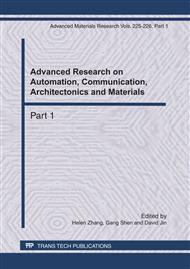[1]
Zhu Xin-feng, Yang Shan-jiao Jiao Gui-zhi: inorganic salt industry. Vol. 42(2010), p.5–8.
Google Scholar
[2]
Claudia Brunlri,Carlo Cremisini,Paolo Massanisso,etal: Joumal of Hazardous Materials B,Vol. 117(2005), pp.55-63.
Google Scholar
[3]
D. Chvedov, S. Ostap, T. Le: Colloids Surf. Vol. 182(2001), p.131–141.
Google Scholar
[4]
E. Kalkan: Eng. Geol. Vol. 87 (2006), p.220–229.
Google Scholar
[5]
N. Yarbasi, E. Kalkan, S. Akbulut: Cold Reg. Sci. Technol. Vol. 48 (2007), p.45–54.
Google Scholar
[6]
R. Apak, E. Tutem, M. Hugul, J. Hizal: Water Res. Vol. 32 (1998), p.430–440.
Google Scholar
[7]
C. Brunori, C. Cremisini: J Hazard Mater. Vol. 117 (2005), p.55.
Google Scholar
[8]
R. Apak, K. G¨ucl¨u, M.H. Turgut: J. Colloid Interf Sci. Vol. 203 (1998), p.122.
Google Scholar
[10]
Han Yi, Wang Jing- gang, Tang Ming-shu: Chemical Environmental Protection. Vol. 25(2005), pp.132-136.
Google Scholar
[11]
Wang Lin-jiang, Wen Xiao-nian, Xie Xiang- li: Guilin Institute of Technology. Vol. 26(2006), pp.543-546.
Google Scholar
[12]
Yu Hua-tong, Chen Ming, Tan Ke-yan: Rock and Mineral Analysis. Vol. 1(2006), pp.45-48.
Google Scholar
[13]
ZouboulisA. I., KydrosK. A: J. Chem. Technol Biotechnol. Vol. 58(1993), pp.95-101.
Google Scholar
[14]
Gupta V K, Gupte M, Sharma S: Wat Res. Vol. 35(2001), pp.1125-1134.
Google Scholar
[15]
Wang Yan-qiu, Huo Wei-zhou: Industrial Water and Wastewater. Vol, 6(2008), pp.82-85.
Google Scholar
[16]
Zhu Chunlei, Luan Zhaokun, Wang Yanqiu: Sep Purif Technol. Vol. 57(2007), pp.161-169.
Google Scholar
[17]
Altundogan H S, Altundogan S, Tmen F: Waste Management. Vol. 20(2000), pp.761-767.
Google Scholar
[18]
Zhang Shuwu, Liu chang, Luan Zhaokun: Acta Scientiae Circumstantiae. Vol. 27(2007), PP. 1972-(1977).
Google Scholar
[19]
Laura Santona, Paola Castaldi, Pietro Melis: Journal of Hazardous Materials B. Vol. 136(2006), p.324–329.
Google Scholar
[20]
Deng Ri-lie, Li Ke-di, Nie Cheng-rong: Fuo Shan University (Natural Science). Vol. 1(2008), pp.73-76.
Google Scholar
[21]
Friesl W, Lombi E: Journal of Plant Nutrition and Soil Science. Vol. 166(2003), pp.191-196.
Google Scholar
[22]
Lombi E, Hamon R. E: Environmental Science and Technology. Vol. 37(2003), pp.979-984.
Google Scholar
[23]
Phillips I. R: Journal of Soil Contamination. Vol. 7(1998), pp.191-212.
Google Scholar
[24]
Muller I, Pluquet E: Water Science and Technology. Vol. 37(1998), pp.379-386.
Google Scholar


